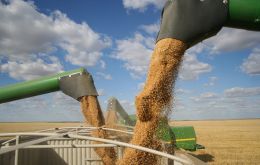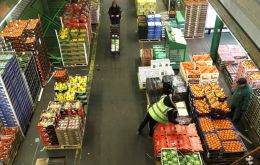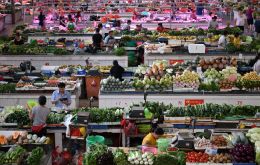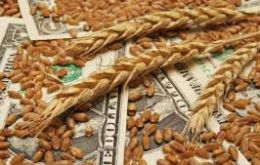MercoPress. South Atlantic News Agency
Tag: Food Price Index
-
Monday, July 12th 2021 - 05:09 UTC
FAO Food Price Index, down 2,55 in June but still 33.9% higher than a year ago

Global food commodity prices fell in June for the first time in 12 months, according to a benchmark United Nations report. The FAO Food Price Index averaged 124.6 points in June 2021, down 2.5% from May, but still 33.9% higher than its level in the same period last year. The decline in June marked the first drop in the Index following twelve consecutive monthly increases
-
Friday, December 4th 2020 - 08:00 UTC
Food commodity prices rose sharply in November to their highest in six years

Global food commodity prices rose sharply in November to their highest level in nearly six years, according to a benchmark United Nations report released on Thursday. The FAO Food Price Index averaged 105.0 points during the month, up 3.9% from October and 6.5% higher than its value a year earlier. The monthly increase was the sharpest since July 2012, putting the index at its highest level since December 2014, the Food and Agriculture Organization said.
-
Tuesday, July 7th 2020 - 09:10 UTC
Dairy prices in June increased 4%, but beef is down because of larger export volumes
In June, global food commodity prices rose for the first time since the beginning of the year driven by a rebound in vegetable oils, sugar and dairy quotations. However, in the cereals and meat markets, most prices remained under downward pressure amid market uncertainties posed by the COVID-19 pandemic.
-
Monday, April 13th 2020 - 09:39 UTC
Food Prices declines sharply in March except rice as countries stockpile

World food prices declined sharply in March, driven mostly by demand-side contractions linked to the effects of the COVID-19 pandemic and the drop in global oil prices due mostly to expectations of economic slowdown as governments roll out restrictions designed to respond to the health crisis.
-
Tuesday, October 8th 2019 - 09:46 UTC
Higher prices for vegetable oils and meat during September, FAO report

Global food prices were steady in September, as lower sugar prices were offset by increased quotations for vegetable oils and meat. The FAO Food Price Index, which tracks monthly changes in the international prices of commonly-traded food commodities, averaged 170 points in September, virtually unchanged from August and 3.3 per cent higher than in the same month in 2018.
-
Monday, November 12th 2018 - 07:11 UTC
FAO Food Price Index dipped in October pushed by dairy, meat and vegetable oils

International food commodity prices dipped in October, as falling dairy, meat and vegetable oils prices more than offset a surge in sugar prices, the United Nations said. The FAO Food Price Index, a measure of the monthly change in international prices of a basket of food commodities, averaged 163.5 points in October, down 0.9 percent from September and 7.4 percent below its level a year earlier.
-
Tuesday, May 23rd 2017 - 14:55 UTC
Global food prices down with expectations of robust supplies in key staples

Global food commodity prices fell in April amid expectations of ongoing robust supplies of many key staples. The FAO Food Prices Index averaged 168 points in April, down 1.8% from March although remaining 10% higher than a year earlier.
-
Tuesday, December 8th 2015 - 00:27 UTC
Major food commodity prices down 18% over a year ago, says FAO index

Major food commodity prices fell in November, reversing about half their rise in the previous month, as the cost of internationally-traded staples, except for sugar, fell across the board. The FAO Food Price Index averaged 156.7 points in November, down 1.6 percent from its revised October average, and 18% below its value a year earlier.
-
Friday, February 6th 2015 - 06:53 UTC
FAO Food Price Index continued de decline in January; cereal record crop anticipated

The FAO Food Price Index continued to decline in January, averaging 182.7 points for the month, or 1.9 percent below its December 2014 level. Lower prices reflect strong production expectations as FAO also raised its 2014 forecast for world cereal production to a record high and noted that early indications for crops in 2015 are favorable.
-
Monday, July 7th 2014 - 22:42 UTC
FAO food price index down for third month running: plenty of corn and wheat

The FAO Food Price Index was down for a third consecutive month in June, a decline mostly influenced by lower wheat, maize and palm oil prices that reflected ample supplies and improved global production prospects for these commodities.
